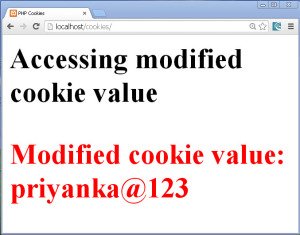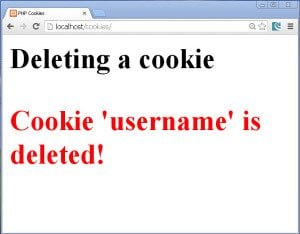Today we will learn a new concept called cookies in this PHP Cookies tutorial.
- HTTP is a stateless protocol. It don’t have the ability to remember the things such as which pages a client visited in a website, which options did he select etc.
- To remember these things cookies are used.
- Cookies are also called as HTTP Cookies, web cookies or browser cookies.
- Cookies are nothing but simple text files that contain some information generated by server.
- We can say when a client connects to a server first time; the server gives an identification number to that client, stores it in a text file and sends this text file known as cookie along with the response to the client.
- When after some period of time, if the client again happens to visit the same server, the cookie file stored at clients PC is sent to that server along with the request. The server then uses this cookie information to identify the client.
- The cookies are mainly used to remember the stateful information in a website such as products added to a cart while purchasing items online, remembering the pages visited in a website, to store the username and password to login to a website so that the user doesn’t have to put username and password everytime to login, to remember the user’s username, etc.
- Cookies can be sometimes harmful because they can bring in viruses with them. Cookies can remain stored in user’s PC or they can vanish when the browser is closed.
- A cookie can only be accessed by the browser that set it, i.e. the cookie set by Firefox cannot be accessed by IE and vice-a-versa.
- So let us learn the mechanism to create, update, delete and use cookies in this tutorial further.
Creating a cookie:
- A cookie is mainly a key value pair. Creating or setting a cookie requires a name, value, expiry time, a domain where it will be accessed, etc.
- The expiry time is the period given in which the client browser will store the cookie. Once this time expires, the browser will forget the cookie.
- The cookie can be set or created using a setcookie() function.
- Syntax of setcookie() function:
setcookie(name,value,expiry,path,domain,security);
- Name: this parameter sets the name of the cookie.
- Value: This is the value of the cookie and is the actual content that you want to store.
- Expiry: This is the time given in seconds after which the cookie will become inaccessible. This parameter is not mandatory. If the expiry of the cookie is not set it will expire automatically when the browser is closed.
- Path: It provides the directories for which the cookie is valid. A single forward slash character makes the cookie to be available for all directories.
- Domain: This can be used to specify the domain in which they are valid. All cookies are only valid for the host and the domain in which they were created.
- Security: it specifies how the cookie should be transmitted. If this parameter is set to 1 i.e. true, the cookie will be transmitted through secure connection using HTTPS. But if this parameter is set to 0 i.e. false, the cookie will be transmitted through unsecure connection using regular HTTP.
<?php
setcookie("username","pranita",time()+3600,"/","",1);
setcookie("pwd","pranita@123");
?>
<html>
<head>
<title>PHP Cookies</title>
<style>
.style{
color:red;
}
</style>
</head>
<body>
<h1>Setting a cookie<h1>
<?php
echo '<br><p class="style">Cookies "username" & "pwd" are set successfully!</p>';?>
</body>
</html>
<?php
setcookie("username","pranita",time()+3600,"/","",1);
setcookie("pwd","pranita@123");
?>
Retrieving a cookie value:
- A very simple way exists to access the cookie values in PHP.
- We use the super global array variable $_COOKIE which is has global scope.
- This $_COOKIE array variable stores the key-value pair of cookie(s) in it.
- Once the cookies are set, they can be accessed on next page load.
- Let us access the cookies username and pwd set in the above example.
- First write the following statement in index.php page:
header("Location:access_cookie.php");
<html> <head> <title>Accessing Cookies</title> </head> <body> <h1>Retrieving Cookies</h1> <?php if(!isset($_COOKIE["username"])) echo "Cookie username expired"; else echo "<br><strong>Username: ".$_COOKIE['username']."</strong>"; if(!isset($_COOKIE["pwd"])) echo "Cookie pwd expired"; else echo "<br><br><strong>Password: ".$_COOKIE['pwd']."<strong>"; ?> </body> </html>
echo "<br><strong>Username: ".$_COOKIE['username']."</strong>";
Updating a cookie:
- To update or modify a cookie value, the way is just use the setcookie() function again to set another value to it.
- Let us see the following example: We have a previously defined cookie named pwd. It has value pranita@123. Let us modify its value to priyanka@123.
- Write the following code in index.php page:
<?php
setcookie("pwd","priyanka@123");
?>
<html>
<head>
<title>PHP Cookies</title>
<style>
.style{
color:red;
}
</style>
</head>
<body>
<h1>Accessing modified cookie value<h1>
<?php
//retrieving modified cookie value
if(isset($_COOKIE["pwd"]))
echo'<p class="style"><strong>Modified cookie value: '.$_COOKIE["pwd"].'</strong></p>';
?>
</body>
</html>
<?php
setcookie("pwd","priyanka@123");
?>
if(isset($_COOKIE["pwd"])) echo'<p class="style"><strong>Modified cookie value: '.$_COOKIE["pwd"].'</strong></p>';
Deleting the cookie:
- Same as modifying the cookie we don’t have any special way to delete the cookie.
- To destroy a cookie we just have to use the setcookie() function again and set its expiration time to be in the past.
- We have created a cookie username at the beginning with 1 hour expiration period. Let us destroy it by purposefully subtracting the 1 hour period from the current time.
- The code is given below:
<?php
setcookie("pwd","priyanka@123");
setcookie("username","",time()-3600);
?>
<html>
<head>
<title>PHP Cookies</title>
<style>
.style{
color:red;
}
</style>
</head>
<body>
<h1>Deleting a cookie<h1>
<?php
//deleting a cookie
echo "<p class=style>Cookie 'username' is deleted!</p>"
?>
</body>
</html>
setcookie("username","",time()-3600);
Thus we learned to deal with cookies in this PHP Cookies tutorial.







